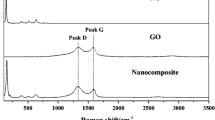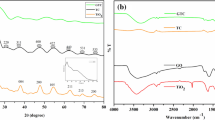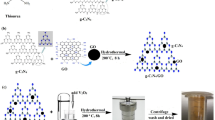Abstract
The elimination of herbicides in aquatic environment is influenced by various biotic or abiotic factors. Thus, efficient, more applicable, and flexible methods are in demand. Photodegradation has been applied to remove three main types of herbicides, phenylurea, triazine, and chloroacetanilide, from water, based on a series of TiO2–reduced graphene oxide nanocomposites. Experimental results showed that the three types of herbicides could be mostly removed under simulated sunlight irradiation for 5 h with the as-prepared photocatalyst. Compared with pure TiO2 or P25, the photodegradation efficiency has been markedly increased. Thus, the present work could promote a new strategy dealing with the pollution of herbicides in aquatic ecosystems.







Similar content being viewed by others
References
Akhavan, O., & Ghaderi, E. (2009). Photocatalytic reduction of graphene oxide nanosheets on TiO2 thin film for photoinactivation of bacteria in solar light irradiation. Journal of Physical Chemistry C, 113, 20214–20220.
Chang, Y. N., Ou, X. M., Zeng, G. M., Gong, J. L., Deng, C. H., Jiang, Y., Liang, J., Yuan, G. Q., Liu, H. Y., & He, X. (2015). Synthesis of magnetic graphene oxide–TiO2 and their antibacterial properties under solar irradiation. Applied Surface Science, 343, 1–10.
Chen, C., Cai, W. M., Long, M. C., Zhou, B. X., Wu, Y. H., Wu, D. Y., & Feng, Y. J. (2010). Synthesis of visible-light responsive graphene oxide/TiO2 composites with p/n heterojunction. ACS Nano, 4, 6425–6432.
Ding, Y. H., Zhang, P., Zhuo, Q., Ren, H. M., Yang, Z. M., & Jiang, Y. (2011). A green approach to the synthesis of reduced graphene oxide nanosheets under UV irradiation. Nanotechnology, 22, 21560121.
Dong, X. F., Liang, S. X., Shi, Z. H., & Sun, H. W. (2016). Development of multi-residue analysis of herbicides in cereal grain by ultra-performance liquid chromatography–electrospray ionization-mass spectrometry. Food Chemistry, 192, 432–440.
Ellegaard-Jensen, L., Aamand, J., Kragelund, B. B., Johnsen, A. H., & Rosendahl, S. (2013). Strains of the soil fungus Mortierellas how different degradation potentials for the phenylurea herbicide diuron. Biodegradation, 24, 765–774.
Elsayed, O. F., Maillard, E., Vuilleumier, S., Millet, M., & Imfeld, G. (2015). Degradation of chloroacetanilide herbicides and bacterial community composition in lab-cale wetlands. Science of the Total Environment, 520, 222–231.
Englert, J. M., Röhrl, J., Schmidt, C. D., Graupner, R., Hundhausen, M., Hauke, F., & Hirsch, A. (2009). Soluble graphene: generation of aqueous graphene solutions aided by a perylenebisimide-based bolaamphiphile. Advanced Materials, 21, 4265–4269.
Evgenidou, E., & Fytianos, K. (2002). Photodegradation of triazine herbicides in aqueous solutions and natural waters. Journal of Agricultural and Food Chemistry, 50, 6423–6427.
Gao, Y. Y., Pu, X. P., Zhang, D. F., Ding, G. Q., Shao, X., & Ma, J. (2012). Combustion synthesis of graphene oxide–TiO2 hybrid materials for photodegradation of methyl orange. Carbon, 50, 4093–4101.
Gaya, U. I., & Abdullah, A. H. (2008). Heterogeneous photocatalytic degradation of organic contaminants over titanium dioxide: A review of fundamentals, progress and problems. Journal of Photochemistry and Photobiology C-Photochemistry Reviews, 9, 1–12.
Grube, A., Donaldson, D., Kiely, T., & Wu, L. (2011). Pesticides industry sales and usage. US: Environmental Protection Agency.
Hummers, W. S., & Offeman, R. E. (1958). Preparation of graphitic oxide. Journal of the American Chemical Society, 80, 1339–1339.
Huovinen, M., Loikkanen, J., Naarala, J., & Vähäkangas, K. (2015). Toxicity of diuron in human cancer cells. Toxicology in Vitro, 29, 1577–1586.
Jang, H. D., Kim, S. K., Chang, H., Roh, K. M., Choi, J. W., & Huang, J. X. (2012). A glucose biosensor based on TiO2-graphene composite. Biosensors & Bioelectronics, 38, 184–188.
Jensen, G. V., Bremholm, M., Lock, N., Deen, G. R., Jensen, T. R., Iversen, B. B., Niederberger, M., Pedersen, J. S., & Birkedal, H. (2010). Anisotropic crystal growth kinetics of anatase TiO2 nanoparticles synthesized in a nonaqueous medium. Chemistry of Materials, 22, 6044–6055.
Liu, X. P., Tang, Y. H., Luo, S. L., Wang, Y., Zhang, X. L., Chen, Y., & Liu, C. B. (2013). Reduced graphene oxide and CuInS2 co-decorated TiO2 nanotube arrays for efficient removal of herbicide 2,4-dichlorophenoxyacetic acid from water. Journal of Photochemistry and Photobiology A-Chemistry, 262, 22–27.
Liu, X. L., Wang, C., Wu, Q. H., & Wang, Z. (2015). Metal-organic framework-templated synthesis of magnetic nanoporous carbon as an efficient absorbent for enrichment of phenylurea herbicides. Analytica Chimica Acta, 870, 67–74.
Main, A. R., Headle, J. V., Peru, K. M., Michel, N. L., Cessna, A. J., & Morrissey, C. A. (2014). Widespread use and frequent detection of neonicotinoid insecticides in wetlands of Canada’s prairie pothole region. PLoS ONE, 9, e91821.
Moisset, S., Tiam, S. K., Feurtet-Mazel, A., Morin, S., Delmas, F., Mazzella, N., & Gonzalez, P. (2015). Genetic and physiological responses of three freshwater diatoms to realistic diuron exposures. Environmental Science and Pollution Research, 22, 4046–4055.
Nguyen-Phan, T., Pham, V. H., Shin, E. W., Pham, H. D., Kim, S., Chung, J. S., Kim, E. J., & Hur, S. H. (2011). The role of graphene oxide content on the adsorption-enhanced photocatalysis of titanium dioxide/graphene oxide nanocomposites. Chemical Engineering Journal, 170, 226–232.
Paule, A., Biaz, A., Leflaive, J., Lawrence, J. R., & Rols, J. L. (2015). Genetic and physiological responses of three freshwater diatoms to realistic diuron exposures. Water, Air, and Soil Pollution, 226, 10.1007/s11270-014-2282-5.
Perera, S. D., Mariano, R. G., Vu, K., Nour, N., Seitz, O., Chabal, Y., & Balkus, K. J. (2012). Hydrothermal synthesis of graphene-TiO2 nanotube composites with enhanced photocatalytic activity. ACS Catalysis, 2, 949–956.
Ramadoss, A., & Kim, S. J. (2013). Improved activity of a graphene-TiO2 hybrid electrode in an electrochemical supercapacitor. Carbon, 63, 434–445.
Shah, M. A. S. A., Park, A. R., Zhang, K., Park, J. H., & Yoo, P. J. (2012). Green synthesis of biphasic-TiO2 reduced graphene oxide nanocomposites with highly enhanced photocatalytic activity. ACS Applied Materials & Interfaces, 4, 3893–3901.
Shao, Y., Cao, C. S., Chen, S. L., He, M., Fang, J. L., Chen, J., Li, X. F., & Li, D. Z. (2015). Investigation of nitrogen doped and carbon species decorated TiO2 with enhanced visible light photocatalytic activity by using chitosan. Applied Catalysis, B: Environmental, 179, 344–351.
Tang, Y. H., Zhang, G., Liu, C. B., Luo, S. L., Xu, X. L., Chen, L., & Wang, B. G. (2013). Magnetic TiO2-graphene composite as a high-performance and recyclable platform for efficient photocatalytic removal of herbicides from water. Journal of Hazardous Materials, 252–253, 115–122.
Wang, F., & Zhang, K. (2011). Reduced graphene oxide–TiO2 nanocomposite with high photocatalystic activity for the degradation of rhodamine B. Journal of Molecular Catalysis A: Chemical, 345, 101–107.
Wang, P. X., Xian, J. J., Chen, J., He, Y. H., Wang, J. X., Li, W. J., Shao, Y., & Li, D. Z. (2014). Preparation, photocatalytic activity, and mechanism of Cd2Sb2O6.8-graphene composite. Applied Catalysis, B: Environmental, 144, 644–653.
Williams, G., Seger, B., & Kamat, P. V. (2008). TiO2-graphene nanocomposites. UV-assisted photocatalytic reduction of graphene oxide. ACS Nano, 2, 1487–1491.
Yang, M. Q., Zhang, N., & Xu, Y. J. (2013). Synthesis of fullerene−, carbon nanotube−, and graphene−TiO2 nanocomposite photocatalysts for selective oxidation: a comparative study. ACS Applied Materials & Interfaces, 5, 1156–1164.
Zhang, H., Lv, X. J., Li, Y. M., Wang, Y., & Li, J. H. (2010). P25-graphene composite as a high performance photocatalyst. ACS Nano, 4, 380–386.
Acknowledgments
This work was supported by the National Scientific and Technology Supporting Program of China (Grant No. 2015BAK45B01), the National Natural Science Foundation of China (Nos. 21572209), the National Science Foundation for Fostering Talents in Basic Research of China (Grant No. J1210064), and the National Instrumentation Program of China (Grant No. 2013YQ510391).
Author information
Authors and Affiliations
Corresponding authors
Electronic supplementary material
Below is the link to the electronic supplementary material.
ESM 1
(DOCX 8179 kb)
Rights and permissions
About this article
Cite this article
Liu, X., Hong, H., Wu, X. et al. Synthesis of TiO2–Reduced Graphene Oxide Nanocomposites for Efficient Adsorption and Photodegradation of Herbicides. Water Air Soil Pollut 227, 21 (2016). https://doi.org/10.1007/s11270-015-2719-5
Received:
Accepted:
Published:
DOI: https://doi.org/10.1007/s11270-015-2719-5




